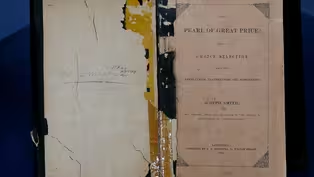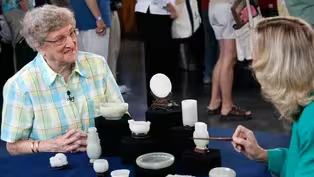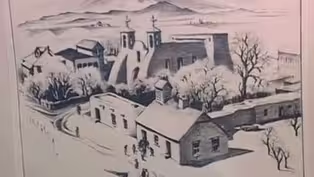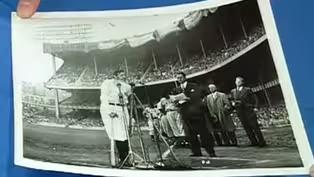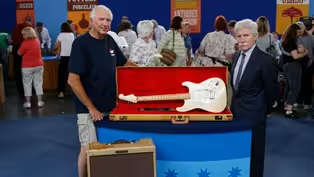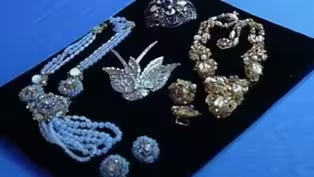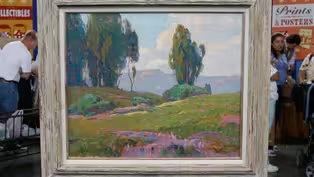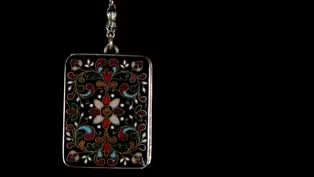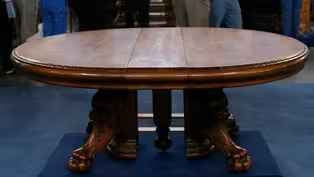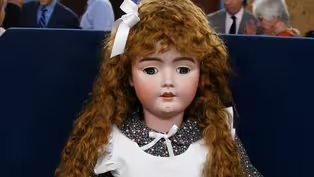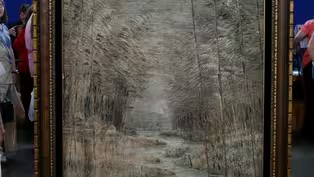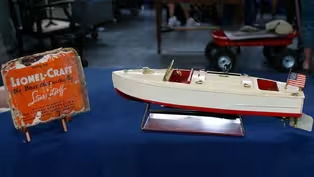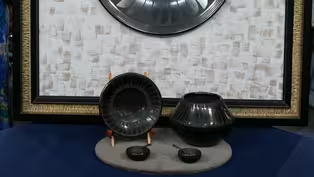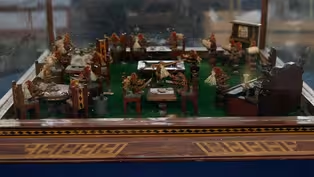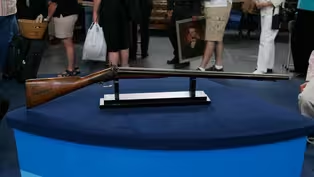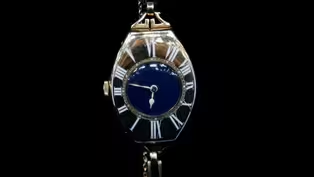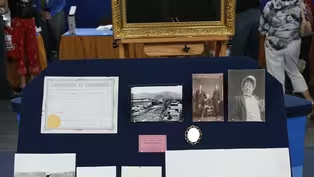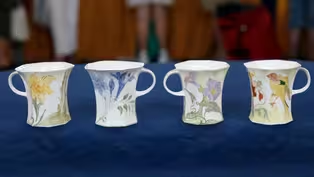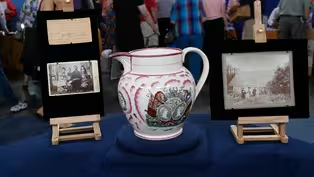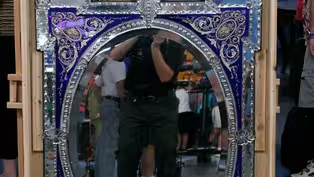
Vintage Salt Lake City 2020
Season 24 Episode 20 | 52m 30sVideo has Closed Captions
Travel with us to Utah’s capital for updated Season 11 appraisals including a $100K-$150K!
Travel to Utah’s capital city for updated Season 11 appraisals including a Philip Margetts archive, Patek Philippe ladies' watches, and a Japanese silk needlework made around 1910. Which is now valued at $100,000-$150,000?
Problems playing video? | Closed Captioning Feedback
Problems playing video? | Closed Captioning Feedback
Funding for ANTIQUES ROADSHOW is provided by Ancestry and American Cruise Lines. Additional funding is provided by public television viewers.

Vintage Salt Lake City 2020
Season 24 Episode 20 | 52m 30sVideo has Closed Captions
Travel to Utah’s capital city for updated Season 11 appraisals including a Philip Margetts archive, Patek Philippe ladies' watches, and a Japanese silk needlework made around 1910. Which is now valued at $100,000-$150,000?
Problems playing video? | Closed Captioning Feedback
How to Watch Antiques Roadshow
Antiques Roadshow is available to stream on pbs.org and the free PBS App, available on iPhone, Apple TV, Android TV, Android smartphones, Amazon Fire TV, Amazon Fire Tablet, Roku, Samsung Smart TV, and Vizio.
Buy Now

ANTIQUES ROADSHOW 2025 Tour!
Enter now for a chance to win free tickets to ANTIQUES ROADSHOW's 2025 Tour! Plus, see which cities we're headed to!Providing Support for PBS.org
Learn Moreabout PBS online sponsorship♪ APPRAISER: It's so hot, you touch this print, it's smoke.
My word.
Takes my breath.
(whoops) (laughs): Are you kidding me?
APPRAISER: Not at all, no.
Oh, my God.
It's a remarkable archive.
♪ CORAL PEÑA: In 2006, "Antiques Roadshow" stopped in Utah's capital, Salt Lake City.
As always, there were smiles.
Wow.
(laughs) PEÑA: And surprises.
My goodness, that's unbelievable.
PEÑA: 14 years make a difference.
How good are you at knowing which values went up, down, or stayed the same?
Find out as we take a fresh look at Salt Lake City.
WOMAN: They were my great-aunt's.
She gave me the gold watch and she gave my mother the diamond watch, and then my mom passed away and left the diamond watch to me.
APPRAISER: These watches, both of them, are made by Patek Philippe, established in Geneva in 1839.
But they usually found their way into very wealthy homes.
They had a simple business plan: to produce the most beautiful and the most expensive luxurious wristwatches, pocket watches in the world.
They were highly prized by queens, kings, people of nobility, Let's talk about the one closest to you, the yellow gold one, 18-karat.
You told me that's the one you usually wear?
That's the one I wear, I've worn it for 20 years.
It's from 1944.
So I figured it was safer to wear that one rather than the diamond one.
Why do you say 1944?
Uh, it's engraved on the back when she bought it.
Okay.
Good, I saw that.
However, I looked up the serial numbers.
Oh.
And they keep very, very good records.
And that watch, in fact, was made between the years of 1910 and 1915.
Really?
Yeah, and what's unusual about it is the shape.
The shape is what we call tonneau, or barrel-shaped.
It's actually back in style.
And another nice feature is, along with the dial, they put these large Roman numerals in white enamel, so it's easy to see, 'cause let's face it, sometimes, as we get older, we need larger numbers.
That's why I don't wear that one.
I can't see the numbers.
That's right, but it's, it's still nice for dress.
Yes, it's very nice.
The diamond watch was made around 1935.
This watch is platinum.
It has about two carats of diamonds in it.
What's interesting is, the diamonds are full cuts.
That's referring to the amount of facets it's had.
Most watch companies were using single cuts.
So here, Patek Philippe went the extra mile, put the better-quality diamonds in.
The movement's been replaced.
It originally came with a mechanical movement-- you knew that.
Ah-- who replaced it?
My mother.
Do you think, maybe, possibly, she has the old movement at home?
No, I've looked.
You've looked.
I've looked, yeah.
Well, you may want to look for another movement from the same period to put back into that watch, 'cause... That's a good idea.
Right now, we should tell everybody there's a, there's a quartz movement in there.
Uh-huh.
Which is easy, you just set it, you don't have to worry about it.
Change the battery once a year.
The value on this watch, with the quartz movement-- everything else is signed Patek, includes the dial-- I would say it's worth $8,000.
Wow.
You spend $500, get the right movement, it's right back up to $10,000.
Oh!
The other watch, the one you wear every day, I hope you continue to wear it every day.
I wear it every day, yeah.
But I got news for you: same amount of money.
$10,000.
Really?
With no diamonds?
With no diamonds, uh, just classic Patek shape.
Very desirable today.
Back then, women who furthered the brand for Patek were people like Queen Victoria... And my Auntie Mabel.
And your... (both laugh) MAN: This shotgun belonged to my great-great-grandfather George Washington Boyd.
He was converted to the church back in Nauvoo, to the Mormon Church, and his parents died, and Caleb Baldwin adopted he and his brother.
Caleb Baldwin was in jail with the prophet Joseph, in Liberty Jail back there.
When he was 19 years old, he came across with the Mormon battalion, and then walked from California back to Utah so that he could marry the daughter of Caleb Baldwin.
Mm-hmm.
She died a year after they were married, in childbirth, and so he then married the other two daughters of Caleb Baldwin.
He then started working for the Overland Mail Company, both as a stagecoach guard and as a stationmaster.
That's, of course, the first stagecoach company out West.
And this was his gun as a shotgun guard.
That's a really great story.
It seems like, has a lot of the local history here.
Yes.
And, and the interesting thing is that the gun speaks to the same history.
Here's the, uh, brand of the Overland Mail Company.
Yes.
The gun, actually, is probably made in Birmingham, England.
Oh, really?
Yes-- I think it was probably made somewhere in around the 1840s, and it was probably sent to San Francisco.
On the top of the barrel here, on the rib, it's marked, "A.J.
Plate, San Francisco."
Uh-huh.
A.J.
Plate was a very famous dealer in firearms in San Francisco.
And he was notorious because he had been sued by the great firearms maker Henry Deringer for trademark infringement, and actually won.
I see, huh.
At some point or other, A.J.
Plate probably sold this to the Overland Mail Company.
Well, San Francisco was the end of the route for the Overland Mail Company, so... Where they stamped it with their brand so that, essentially, probably, nobody'd steal it.
(chuckles) These guns on the market are very scarce, that actually have stagecoach markings.
Most of the ones you'll see are for Wells Fargo.
Yes.
And many of them are fake.
This is actually the first Overland Mail Company coach gun that I've seen.
Wow, that's interesting.
There were a number of these guns that were made in Birmingham, England, exported to the States for sale.
So the gun itself is actually not that rare, and I would figure that at auction, it would probably be only worth about $300.
Um, but I think, with your family history and such, stamped "Overland Mail Company," that the gun would be worth at least $3,000 at auction.
Okay.
If not more.
All right, thank you very much.
It's a sign I have seen-- they're not uncommon.
Is it?
But it's still a really nice advertising piece.
You can look down here where you did a little bit of damage.
Yeah.
The key to tin advertising is condition.
Luckily, you've preserved the centerpiece.
The face is just absolutely gorgeous.
Great tin litho sign, but the damage to the bottom does affect the value pretty dramatically.
Teco mass-produced pottery, to an extent.
These are molded pieces, and the last one of these I had I sold, I think I got, like, $2,000 for it, but this is more like $2,500 to $3,500, because of the glazing.
This is a piece of painted matte which is a very rare Rookwood line.
They only made it for a few years.
This would retail for between $6,500 and $8,500.
(laughs): My God.
MAN: This was done by my great-grandfather.
He did this with a steel pen, by hand.
And this was a gift, or a surprise, for his wife.
It was a tradition that was done a lot on the East Coast, and made its way out here.
I love the fact that it's local to Utah.
MAN: When my uncle passed away, it was just left in the house and nobody else wanted it, so I took it.
APPRAISER: It's an etching by Gene Kloss.
And you can see her signature down here.
She was an artist who worked in Taos, New Mexico, from the 1930s through the 1970s.
She made lots of prints and just died recently.
Oh.
This print dates from the early part of her career in the late 1930s.
And it's a beautiful print.
And I've got to tell you, her market has shot up dramatically in the last five years.
It's so hot, you touch this print, it's smoke.
Oh, okay, okay.
It's that hot.
This is a print that, five years ago, may have sold for $500 to $700.
Now, at auction, it'd bring about $3,000.
Oh, sweet, that's good.
So, it's great for you to have.
Oh, that's good to know.
Really nice print.
WOMAN: This is a first edition of "The Pearl of Great Price."
It was printed in Liverpool, England, in 1851.
I had a great-great-grandfather who had joined the church in England in 1840.
And I think that this must have been one of his possessions.
My grandfather came to America in 1884.
Okay.
And brought this with him.
Well, as you pointed out, this is the Liverpool edition of "The Pearl of Great Price."
Mm-hmm.
Published, uh, by the British mission in 1851.
This was the third volume of Mormon scripture.
Joseph Smith had published "The Book of Mormon" in 1830, followed by "The Doctrine and Covenants" in 1835, and this volume wasn't published until after his death.
The signature on the inside board here, of Joseph Smith, isn't that of the author and translator of "The Pearl of Great Price," because Joseph Smith was martyred, uh, in 1844.
Mm-hmm.
And this book wasn't, uh, published until 1851.
The second edition of this book wasn't published until 1878, one year after Brigham Young's death.
So this is an early volume of LDS scripture.
These salmon wraps here are original.
This is the half-title.
And the title page with the '51 date.
And then I'm gonna turn the book all the way over.
It's, uh, in these crudely printed homemade wrappers.
Mm-hmm.
But what they've done, all these years, is protect this salmon wrapper on the back that lists other current books and their prices of the day.
And that's what makes this copy extremely unusual.
"Pearls of Great Prices" aren't all that unusual.
But copies in these original wrappers are almost unheard of.
And that, coupled with one other thing that I'll show you here, this has the facsimile from the Book of Abraham, the foldout plate.
Mm-hmm.
There are three of them in here, but...
This plate, because of the foldout nature of the plate... Mm-hmm.
Are almost always missing from the book.
So it's very, very unusual that this, this page is still intact in the book.
Ordinary copies sell for perhaps $7,500 to $10,000.
But your copy would fetch somewhere between $45,000 to $55,000.
(softly): Oh.
Did you have any idea it was worth that much money?
No, I didn't.
I've only ever had a "Pearl of Great Price" in wrappers once before in my entire career of 35 years.
Oh!
I just inherited it from an aunt who unfortunately just passed away a year ago.
And it was passed down in the family from her grandparents to her parents to her.
And I was quite fortunate.
My sister and I inherited quite a bit of furniture from her.
And this was one of the pieces I acquired.
What you have is a golden oak expanding dining table made 1890, give or take a few years.
Okay.
It's American.
In this particular kind of furniture, the more over-the-top it is, the better.
This is the height of what I call a historic revival period, and in the best pieces, there's hand-carving as well as machine-carving.
Everybody loves these paw feet with the foliate carving coming back, and all of this carving in here is done by hand.
The other thing that's great about it is...
It's a big table, you know, it's wider-- some of these are only, like, 42 or 44 inches.
I guess this one is probably 48 or 52?
62.
62 without the leaf.
62, without the leaf.
62.
62 diameter, mm-hmm.
All right, that's really good.
And I have three leaves.
Oversized is, is really good for something like this.
Now, the other thing that attracts them to it is the fact that it has this beautiful tigering grain.
Isn't it?
That's what some people call it tiger oak.
This is actually quarter-sawn, and it's a veneer.
It is?
Yeah, but you know, that's not... That's, that's the way it's supposed to be.
I'll be darned, I did not know that.
That's not a bad thing.
Let's spin this around and look at this.
We had a big discussion at the furniture table about this.
When these were ordered new, they ordered how many ever leaves they wanted to use with it.
And you have three one-foot leaves?
Correct.
But I think these are the right leaves.
After much discussion-- because, look at the color.
Now, these are solid, these are not veneered.
These don't have the tiger graining.
They don't.
But the leaves, I bet you, were in stock.
And they just ordered how many ever they want.
Value-wise, these things are hot as a firecracker.
It would bring, at an auction, $3,500, $4,500.
My aunt's dream was to have one of her pieces of furniture in "Antiques Roadshow."
WOMAN: These black dishes were my grandmother's.
And I believe they're from Maria, the potters from New Mexico.
And I believe she bought this plate for $25.
I want to know if she made a mistake by framing this.
Let's start with these two pieces.
They're just little salt cellars with silver spoons.
Uh-huh.
They're not signed, they're probably not Maria.
Probably not worth a lot.
Okay.
Maybe a couple of hundred dollars for both of them, maybe.
The plates are Maria.
They were made in the late '50s, I suspect.
They're signed by Maria and her son Popovi Da.
And they're from San Ildefonso Pueblo, south of Santa Fe.
Mm-hmm.
On the Rio Grande river.
And we know these were made in the late '50s because they don't have numbers or dates.
Right.
They just have the two signatures.
And just to make sure, we pulled the cardboard off of this one, and it's the same signature.
And if you look down here on the bottom, they're all signed like this.
"Maria and Popovi."
She paid $25 for it?
That's what I was told.
About the framing, it would've been better if she didn't, but, you know, it may be that it's in better shape because she framed it up.
Right.
So I think that's okay.
It's a new group that's buying them.
The prices have changed dramatically.
And the best pottery that Maria ever produced was with her son, and this is it, and this is some of the earliest things she produced.
Oh, really.
And you know this is a feather design.
I read something about that.
All three of them are feather designs.
If these were to come up at a prominent auction house right now, for these three pieces, $32,000 on the low end, $45,000 on the high end.
Oh, my.
(chuckles) And if you get two people in the room who don't have one, and want a big one, it's gonna go for more than that.
Wow.
So congratulations.
Wow.
(laughs) Thank you.
You're welcome-- it's her classic stuff.
Yeah.
It's as good as it gets.
APPRAISER: It is a British bicycle, was made in about 1943, and these were used by commandos, by paratroopers.
It does break in half.
And they were used for mobility for these special troops that where a lot of times dropped behind the lines.
You can ride it, if you like.
Yeah, no, I think I'll pass on that.
APPRAISER: What's so unusual about this cabinet is this beautiful embossed lithograph-tin front.
And when you open it up, it's very interesting, because it still has some of the, um, original names of the dyes across the front.
And this would've been on the counter, so the customer would've opened it and picked out their dyes.
APPRAISER: This is an incredible edition of Henry Wadsworth Longfellow's "Evangeline," which, as you'll see from the title page, has all these beautiful extra illustrations that were done on it.
And it's been signed by the man who did all of the decorations, John Tearle.
And he did all of these extra illustrations, which we call in the book world illuminations.
I've been collecting jewelry since I was a little girl.
I started garage sale-ing with my Aunt Helen, who taught me to just buy sparkly things.
And so I just like big and gaudy, I guess.
You know, so do I.
What you have here is an amazing collection.
You have two Miriam Haskell necklace and earring sets.
Wonderful.
From the 1940s and 1950s.
Each one of your sets is in the $1,500 to $2,000 range.
Wow, wow, that's great.
Okay?
It's gonna get better.
Okay.
The bird in the middle?
Mm-hmm.
That is by Trifari.
Uh-huh.
I believe it's designed by Alfred Philippe.
It has all the bells and whistles of a major Trifari pin.
What do you think it's worth?
$150?
$1,000-plus.
(gasps) Wow, that's wonderful.
You don't see this very often.
It's a, I fell in love with that one.
I certainly did.
Now tell me about this multicolored one in the very top.
That piece I found at an estate sale here in Salt Lake.
And the woman said she was the great-niece of Douglas Fairbanks, Jr., and I thought it was really beautiful.
I paid $25 for it.
Excellent.
I did good?
You did good.
This piece is Austro-Hungarian.
Mm-hmm.
Turn-of-the-century 1900s.
It has genuine rubies, amethysts, pearls, enameling.
What do you think it might be worth?
$500.
$2,500.
Wow.
(laughs) Wow, well, that's very nice.
You are, you are a major shopper, kid.
I love it.
WOMAN: This is a piece that my husband bought, actually, at a thrift store.
He was looking for frames.
And he makes it a habit of buying paintings at thrift stores just for the frames.
And when he got this home, we were looking at it and decided that we really liked it, so... Do you know anything about who the artist is?
I know that he's from California, and that's about all I know.
Well, the name of the artist is Dana Bartlett.
And, as we can see over here, the, the piece is signed.
Bartlett was from Michigan, and he was born there in 1882.
And goes to New York City early on to study at the Art Students League with William Merritt Chase, who is probably the premier American Impressionist landscape painter.
So he had very, very good training.
In 1915, he moves on to San Francisco, where he sets up a studio.
He's a member of what's called the Eucalyptus School, or a group of California Impressionist painters, who worked outdoors.
They were called Plein-Air Painters.
They embraced the California countryside.
Other than the landscape subjects, one of the signature characteristics of the Plein-Air Painters is a very heavy texture to the paint, and you can see here, the impasto, or the paint layer, is built up very, very thickly.
The other plus in California Plein-Air paintings has to do with very bright colors.
And as you can see here, this brilliant purple is just incredible.
And so for collectors of this kind of material, this is exactly what they're looking for.
We actually see a little bit of a ridge and we see a little bit of paint loss.
Now, that is a result of the stretcher bar on the back.
This painting is actually in excellent condition-- it's in its original state, nothing's ever been done to it, so it's, that's really great, but it does have this little problem where it's buckled in that area.
The same is true for the upper portion of the canvas, so at some point, you might want to have it restored or relined.
The painting is called "Early Spring, Verdugo Hills," and it's signed and inscribed on the stretcher on the back.
Verdugo Hills is in the southern part of California.
Can you tell me when you got it and what was paid for it?
We got it about five years ago and he paid five dollars.
Five dollars, wow!
(laughing): For just five dollars.
Well, if you also looked on the back of the painting, you'll notice a price-- it, it sold for $250.
Or that was the asking price when the artist painted it.
And this was probably done sometime around the 1930s, and that's partially based upon the style of the painting, as well as the frame, which is this milky, chalky-type frame from the '30s, or it could be early '40s.
Bartlett's work comes on the market at auction once in a great while, and there actually was one that sold at auction in the last few months for as much as $20,000.
Oh, wow!
It was the same size as this.
Not as good, in my opinion.
And so I think this would be at worth, worth at least $20,000, if not a little more.
Oh, wow.
So you made a very good investment.
Wow.
(gasps) Oh, yeah, wow.
MAN: I bought this from a gentleman I work with.
He bought it from a guitar instructor in Ogden, Utah.
I bought it in 1960, '61, and it happens to be a '57.
And I've really enjoyed playing it.
I've taken lessons... You still play it?
Yes.
Okay.
This is a model Stratocaster, you know that.
Yes.
The Fender company made it in '57.
It's possible that it's a '58.
And it's-- and blonde finish.
I understand they didn't make the blonde finish until '58.
Is that right?
That was the Olympic White finish.
But you can see a lot of the grain through the finish here.
Yes, huh?
That makes me feel more like this is the blonde finish, rather than the Olympic White.
The Olympic White was a bit more opaque white finish.
This you can see through a bit more.
Uh-huh.
And you can see the serial number right there.
And that shows me that it's some time in '57, but I think quite late '57.
It has a very nice neck on it.
It's easy to play.
Oh, the neck is fabulous.
It's a nice-feeling neck.
Without opening this up and without looking inside and taking the pickups apart and everything else, visually, it looks like it's completely original.
Has anything ever been done to it, to your knowledge, since 1961?
Not other than changing strings.
Maybe adjustment on the neck.
Maple neck, maple fingerboard, black dot inlays, original decal, untouched.
Original pickups, original whammy bar, Tremolo bar.
Original tweed case with red lining.
Uh-huh.
Looks like a period Fender Deluxe amplifier, which looks to be in okay condition.
How much did you pay for it, back in 1961?
I paid... As much as I can recall, about $300.
$300.
Which was a big decision.
(laughs): I can imagine.
It might surprise you to know that these models, in the last year or so, have really skyrocketed.
All solid-body Fender and Gibson guitars have gone a little bit crazy.
Is that right?
So I would say this one, in this condition, which is, I'd say, about a eight-and-a-half of ten scale, in a retail situation, this outfit with the case and the strap and the amplifier, and the guitar being this original, $50,000 to $60,000.
Oh... My word.
Takes my breath.
(whoops) WOMAN: My husband and I attended an antique show here in Salt Lake a couple of months ago.
I happened to see this in a case with a lot of other jewelry, and I thought it was very interesting and unique.
And I kind of passed by the jewelry three or four times, kind of deciding what I wanted to do, and I finally asked the dealer about it, and she couldn't tell me anything other than she'd bought it at an estate sale.
How much did you pay for this?
I paid $175 for it.
Did you kind of negotiate a little bit, or...?
Um... You can tell me, it's okay.
I didn't negotiate.
You didn't... You said, "All right..." I just loved it so much that I wanted... $175, you wrote the check.
Mm-hmm, yeah.
This is a very rare item-- I've seen examples of these in museums in Europe, and I've handled them.
The item itself is called a vinaigrette, sort of like the salad dressing.
There are no marks we could find.
It's either Swiss or French.
Swiss, okay.
In the early 19th century, there wasn't garbagemen that carted away the trash.
People threw the stuff out the window.
And when you left your house, you would encounter odors that made you just choke.
So they invented a device called the vinaigrette.
And it was a box or a little trinket carried to revive oneself if one felt faint.
Oh.
I don't think that the dealer that sold it to you was aware of the fact that it's 18-karat gold.
Okay.
And I don't think you knew that, either.
No, I didn't, okay.
The material that makes the color on this object is enamel, and it's polychrome, meaning many colors of enamel, in beautiful designs on both sides.
The other side is different and just as pretty as the top.
The connecting chain is enameled all around, as is the top piece.
And inside is a gold pierced grill with beautiful decoration.
But underneath the grill is a sponge.
They would soak that sponge in an aromatic solution, sort of a mixture of perfume and ammonia, like smelling salts.
Oh.
So here's madam, and she's faint.
"Oh, my goodness, I, I can't..." And... (inhales sharply) (exhales): "I can carry on now, I can make it to the coach."
(laughs) That was the concept of the vinaigrette.
These are quite rare.
We don't see a lot of them.
It's museum-quality and just beautiful.
Conservatively, the retail value of a piece like this is about $7,500.
Oh, my goodness.
In today's market.
(laughs): Oh...
So, let me tell you... Wow.
For $175, you did phenomenally well.
(laughs) I'm amazed-- I'm amazed.
After the, uh, Second World War, my husband, uh, came back from Germany, and then he was sent to Korea.
Really?
He was a chemist, and he was in charge of the chemical plants over there.
A Korean wanted something American-- I really cannot remember what it was-- and he offered to trade my husband whatever he gave him American for this jade collection.
So your husband got this in trade, and you don't know for what?
No, I don't remember.
You know, during the war, it could've been cigarettes or soaps, you know, stockings.
I really don't remember.
You know, even though he got this in Korea, these are Chinese jades.
The vast majority of these were carved in the 18th century during the reign of the emperor Qianlong.
That long ago?
Yes.
He loved white jade, which was mined in, predominantly in Northwest China.
And his taste for these wonderful small carvings-- scholars' objects, such as this bi disc, this little censer, and this brush washer, were all made for the imperial court.
Since he set the taste, other wealthy merchants decided that they wanted to collect the things that the emperor collected.
Of the entire collection, the most important pieces are this piece, the bi disc, the censer, and the incense vase, which would each bring, individually, between $10,000 to $15,000 at auction.
Uh... Each?
The entire collection would bring, probably, now because the market is really hot, $40,000 to $60,000, easily, at auction.
Wow.
What a wonderful acquisition for trade.
Mm.
These are, these are really terrific, beautifully carved examples from the reign of the emperor Qianlong.
That much?
I'm so excited that you brought them in.
My children will be very interested, too, because, as you know, eventually, it'll be theirs.
(chuckles) I'm really very, very pleased.
Astounded.
APPRAISER: This is what we call a scratch-built model.
Literally, every piece would've been handmade.
It comes out of a real tradition of, of love of railroading, and, really, a love of making engineering models.
We can actually kind of see that it's a working model because it has a boiler and all the appropriate fixtures to be a steam engine.
You have roughly, somewhere around 85, 95 diamonds in here.
And it's magnificently made, because if you turn it over, on the other side, every one of these diamond holes, Asscher cuts, are all done by hand.
Wow.
The small stones, the green ones are...
They're all real emeralds.
Okay.
Usually they were synthetic, but these happen to be real.
APPRAISER: James Taylor Harwood was actually a native.
WOMAN: Yeah, from Lehi.
He was born here and spent his whole life here.
Yeah.
And was actually taught by several of the people who were the first generation of well-known artists in Utah, who were people who did come from other places.
It's a lovely watercolor.
Works by this artist do not come on the, on the market very often.
MAN: I got it at an auction in Phoenix, Arizona.
APPRAISER: What did you pay for it?
Uh, five dollars.
Five dollars.
Well, you came up with one of the more iconic images in baseball history.
It's, uh, from June 13, 1948.
It's Babe's farewell speech to the fans at Yankee Stadium.
There's a very famous image by a photographer named Nat Fein, taken from behind.
We've seen that image.
This is obviously from another angle, and it's a very, very poignant image of the gravely ill Babe Ruth.
He would die two months later.
It's a phenomenal photograph.
Baseball photography has become very, very popular of late, and this is a, uh, a vintage image, a vintage wire photo.
It's a beautiful, beautiful photograph.
Five dollars?
Five dollars.
What a great find.
I was happy to see it.
At auction, a photograph like this would bring at least $300 to $400.
Wow.
So what a great, great find.
Yeah, it was.
I'm glad I kept it.
WOMAN: A friend of the family won the doll in a raffle for 25 cents.
APPRAISER: Oh.
She was given to my grandmother in 1902, and the shoes and socks are original.
And my earliest recollection was at five years old.
I'd go visit my grandmother and look at this doll and beg to play with her.
And she would never allow any of us to play with her, so...
I'm sure of that.
And that's why she has survived for so long.
Yes.
And she was in that cabinet all these years.
And she was supposed to go to the oldest granddaughter, who did not want her.
So I got her, and I was so thrilled because I'd been in love with this doll for so many years.
Oh, how wonderful.
This is a beautiful doll, and she was made in Germany between 1895 and 1905... Oh, wow.
By a company called Heinrich Handwerck.
Actually, the head was made by Simon & Halbig, who was a porcelain manufacturer that also produced a lot of doll heads for a lot of the other German companies.
Uh-huh.
And what's very special about her is that she's very large.
This doll was made in several different sizes.
Uh-huh.
And a lot of people really desire the larger sizes, so anything over 38 inches is considered really large.
She has beautiful blue glass eyes, and we always look for eyes that sleep, and it's very lovely.
She's got thick brows, she's got an open mouth with teeth.
What's especially nice about her is her original mohair wig.
What they did is, they added pieces to make it look longer.
Uh-huh.
Because the goats don't grow the hair that long.
(laughs) This is in beautiful condition.
It's a wonderful color.
Some of these wigs go for a lot of money.
The body is made of composition and wood.
And she has her original shoes.
They are quite nice.
They're made of leather.
The dress is not original.
And I think-- did you make the dress?
I made the dress.
Yes.
The dress that I remember her, uh, being in was just a crepe paper dress...
Okay.
That my aunt made for her.
Okay.
And so, I never saw the original dress.
Well, I think you would be very interested to know that this doll books for about, retail price of $3,200 to $3,500.
Okay.
If this doll had all of the original clothes...
Yes.
And original dress, she would probably retail for about $3,700.
WOMAN: My husband's great-uncle Henry was an avid book collector.
When my husband's father died, the book collection came to us.
We've just treasured it.
Uh, reason I brought it in today was because I was wondering if we should invest in some work on the, on the spine.
All right, well, first of all, "Porgy and Bess" is one of the great American classics.
There's no question.
The front page is beautifully illustrated.
This book was printed in 1935.
Gershwin and Heyward got together about a year or so earlier, and they put together the opera.
And it's "the" American opera.
I mean, it's fabulous.
It was also a flop.
One of the problems they had with it was, opera lovers didn't think it was an opera, there was a racial issue, and then it was hugely expensive.
It ran a little over a hundred, uh, performances, but didn't go anywhere.
You have the music.
But the best thing about this book is, when you get to the back...
This is the limited edition, one of 250 copies, this is number 164, and it's signed by George Gershwin, Heyward, Ira Gershwin, the director...
It's one of 250 copies that all of them signed.
And, of course, George Gershwin died just a few years later, tragically, at eight-- 38 years old.
What he produced in doing something like this, I just wonder what could have gone on after that.
Ira lived long on into his 80s.
After George Gershwin died, then "Porgy and Bess," in the '40s, became a classic.
In the '50s, they did a movie with Dorothy Dandridge and Sidney Poitier.
There are some condition problems.
The hinge is a little bit cracked.
The box is a little bit worn around the edges.
It would be very easy for a good bookbinder to repair.
In the condition it's in now, it's probably worth $5,000, maybe $7,000.
With a little bit of restoration-- maybe $200, $300, $400-- it's probably closer to $10,000.
My... Is this a grasscloth?
Yeah, and, and it's very much integral... And... ...to the value.
Oh.
WOMAN: They came from my husband's grandparents' house, and they appear to be hand-painted and very dainty and thin.
And they've always been our favorites and they have the Rozenburg mark on the bottom.
But that's all I know.
Okay.
Indeed, they are Rozenburg.
Hmm.
And, indeed, they are very dainty.
Mm.
And they are hand-painted.
They are eggshell porcelain, and were made by Rozenburg in the Hague in Holland roughly between 1895 and 1905.
They are all unique pieces.
They are highly collectible, because they're, they're just beautiful Art Nouveau examples.
You'll see, it says "Rozenburg, den Haag."
Mm-hmm.
Which is the Hague in, in Holland.
Mm-hmm.
And there are some marks on here indicate who the artists are.
I do not know the individual artists, but they are individually done and they are unique.
And as you mentioned, two of these are somewhat similar.
The one closest to you has, has the bird on it, which is really a plus, anytime you have animals or unusual subject matter.
At auction, $800 to $1,000 for that one piece.
Wow.
The other ones might be slightly less than that.
$700 to $900 at auction.
So, as a collection, are they more desirable, price-wise?
I, if I were to sell them at auction, I would sell them each individually, because not everybody's gonna like the same ones.
Yeah, I love them-- thank you.
This is one of the final great pieces of American art glass, and it is called Durand.
It's not signed, but the reason I knew it was Durand is because I recognize the design on it, which is this pattern, which we call the King Tut pattern.
The photographer's name is John K. Hillers.
What's really unusual about this photograph is the technique.
If we look at the image, we see that it's on glass.
The fact that the photograph was made on glass gives it this extraordinary detail.
It's a silk tapestry.
It's all silk thread.
Uh, there are a couple of places where there is a little damage.
It's my understanding that it's 400 years old from Beijing, China.
I know it came from China.
My aunt purchased it there around 1934.
I've always wondered whether it was night or day.
As the light changes on it, it appears to be a, a scene with the moon.
And yet I'm not sure.
Now, pardon the pun, but I'm gonna unravel this mystery.
Okay.
It's very monochromatic, which is why you're having a hard time telling what it is.
These silk threads were actually dyed pretty bright colors, originally.
Oh... Now, the dyes, though... Age.
In the sun, faded, and they fade quite rapidly.
So what one ends up with is this very monochromatic scene.
Here in the center is a small orb.
I think that's probably the moon.
Down here in the lower section, you have this wonderful sort of river view, little stream running through rushes.
Uh-huh.
And you've also got over here on the side a little rustic hut, and it's in this bamboo grove.
Now, you think it's a tapestry.
It's actually not.
A tapestry is a woven technique.
Ah.
And embroidery is a needlework technique.
So these are actually separate threads that have been sewn onto a silk backing.
So it's not a tapestry.
It's actually not Chinese.
(chuckles): Oh.
It's bought in China, but it's actually Japanese.
Oh, my goodness.
This particular type of embroidery was very popular in Japan toward the end of the 19th century and the early 20th century.
Japan was industrializing.
They were trying to make products for the West.
Ah.
So they wanted to create something that would appeal to a Western audience, even if that Western audience was in Beijing, China.
Now, the other part of this was the age.
Your aunt had said it was 400 years old.
Obviously, it's not.
It's not 400 years old, because this technique did not exist at the time.
It certainly would have deteriorated far beyond what you see here.
But more-- most importantly, this kind of expansive, wonderful landscape view, which is basically a Western perspective, did not exist in Japan to any great degree until the 20th century.
Ah-hah, so...
So it's actually, may have dated back as early as 1900 to 1920-- that kind of time frame.
It was not new when your aunt bought it.
Now, in terms of the condition, you'll notice throughout here there are little bald spots.
I wouldn't do anything to it-- it's all okay.
Okay.
Now, I would say, if we sold this at auction, it would make somewhere in the order of about $1,500 to $2,500, maybe $2,000 to $3,000.
Well, that's great.
Somewhere in that range.
And, you know, if it were all bright and pristine, it would be worth as much as $6,000 to $8,000.
MAN: It was given to me, as I remembered, for a Christmas present, about 1934, 1935.
We lived close to a park that had a nice lake, and my parents would walk me over and we used to wind it up and put it on the water.
One of the things I love on the "Roadshow" is when I find a toy and I can talk to the original owner who played with it.
And I was sort of amazed when you told me that you played with it, because, look at the condition.
It's extraordinary.
When you told me that you put it in water, I just-- I was shocked.
(chuckles) So how did it stay in such good condition?
Well, when I played it out of the water, according to some of the instruction I had and my, and my father, I'd take it out, dry it off, and beeswax it, and so it'd shine.
And my father told me it'd go faster that way.
And that's probably why it survived so well.
You have the remnants of the box.
I guess the box fell apart on your way here.
Yeah, it did.
But I noticed here these original instructions that were in the box, and it says right here, "It is important that this boat "be thoroughly dried after operating "to prevent it from rusting, "especially after using in salt water.
A coating of wax will help preserve the finish."
That's where I got it.
Well, that's why you have this boat in such amazing condition.
It's Lionel, and Lionel is famous for Lionel Trains.
And not many people know that Lionel made a speedboat.
As you know, it's clockwork, and it has a very powerful motor.
(whirring) Spins away.
And what, of course, we love is when we find a toy in amazing condition, and it's extraordinary that this is so original.
It even has the original flag.
Now, how did it happen that you just managed to hold on to it?
Well, before I went in the Navy, um, I packed it up in the box with, with padding around it and stored it.
And I came home from the Navy, and I think I ran it one or two times.
I put it back in the box, and it's been with me ever since.
Well, because you took such good care of it and because you followed the instructions, a boat like this in this condition on today's market would probably fetch at auction between $1,200 and $1,500.
My goodness, that's unbelievable.
It is.
So... Oh, I really appreciate it.
WOMAN: My ancestors are from Guernsey in the Channel Islands, and they came through Ellis Island in 1892.
It was Daniel Dorries, who's the father in that picture.
That's the gentleman here?
Mm-hmm.
He's my great- great-grandfather.
This was taken in Guernsey, and it's Daniel's house.
And how does this letter here tie in with your information?
Um, those were notes that came with it.
I inherited it from my great-aunt.
I was glad that came with it, because it gave me a little bit of information, because I don't know much about it.
Well, some of them you believe, and some of them you have to take with a grain of salt.
Right.
And the jug.
What do you know about it?
My great-aunt told me that it was very special, and she said-- and also in that older note-- that they used it for buttermilk, which seems amazing.
Yeah, I think this was more ornamental.
Most of the pink lustre of this sort in a piece of earthenware was made in a town in England called Sunderland.
Okay.
Sunderland had numerous potteries.
And there were several potteries that specialized in the manufacture and decoration of pink lustre on their wares.
Now, one of the companies, Dixon & Company, was also known for doing a lot of commemorative wares.
Hmm.
Now, in England, any reason, any excuse to make commemorative wares for any occasion, they did it.
We have flags on this side, and we have a nautical verse on the front.
Mm-hmm, which is so beautiful.
And then, on this side, we have these two nautical gentlemen holding their flags.
Now if we go back to this side, the two portraits that we have on this side... Uh-huh.
One is supposedly depicting Napoleon III.
Uh-huh.
And one is depicting Queen Victoria.
Mm.
Now, the way this is produced is with transfer prints.
It's a printed decoration that has then been color-enhanced by hand.
Ah.
All of the designs here all represent the Crimean War.
Oh.
Now, the Crimean War took place between 1853 and 1856.
Uh-huh.
So it makes it relatively easy to date the jug between those periods.
Mm-hmm.
The alliance of France and England against Imperial Russia.
So this was a bonded friendship between the two countries.
And this was the reason that the jug was produced.
Ooh.
It's a very large example.
Jugs they made in all different sizes, but this is really what I would call a beefy piece of pottery.
(laughs) These jugs actually were tremendously popular, starting from about the mid-1980s.
And we don't have as many collectors now as we used to have.
And I think it probably even peaked then, versus what it might be worth now.
Mm-hmm.
On today's market, I would expect it to sell at auction somewhere in the $1,500 to $2,500 range.
Oh, wonderful.
It's in great condition, and I'm thrilled that you brought it in.
Oh, great.
WOMAN: This is my great-grandfather Phil Margetts.
He was born in England, and he came to Salt Lake City in 1850.
He mostly made a living as a blacksmith and also as an owner of a... a wine depot.
But his real passion was acting.
And he was, in fact, the best-known and best-loved actor in the Utah Territory from about 1850 to his retirement in 1905.
In fact, he was really considered the first main Mormon actor.
It's an exceptional archive, and we've only selected a few pieces.
The first item is his certificate of citizenship.
As you mentioned, he came to the United States in the 1850s.
And here is his certificate from 1857, making him a citizen of the Utah Territory.
Here's a great period photograph of Salt Lake City.
And as you mentioned, he was a wine merchant.
And here is his establishment.
Here he is with Brigham Young's nephew, S.B.
Young.
Here he is performing...
In character.
In character.
Do you know which character he is in that?
Yes, he's playing Mr. Toodles there.
Mr. Toodles, it's great.
Here's a small portrait of him.
We also see a ticket to a performance here in Salt Lake City.
One of the most significant aspects of the archive are these three letters, all of which were written to your great-grandfather by Brigham Young, who, at this time, was well established here in Salt Lake City.
The content of the letters shows that he was a great supporter of your, your great-grandfather, and in fact, helped him develop the theater here.
Yes.
And the details that are given about monies that were going to be used to develop the theater really create a sense of history.
This letter, which he has written to his wife, shows an amazing period in history, right when the United States Army was believed to be moving into Salt Lake City.
And what does he say?
Well, uh, he thinks it's all a bunch of nonsense.
(laughs) Uh, he's just headed back East.
One of the first rumors that he heard was that the Army was coming out, and he thought it was all humbug.
And of course, it did come, it did come to pass.
Yes, they did come.
And that's just some of the great content that we have.
What we also have are printed playbills.
We have his diary.
We also have his own handwritten scripts, which he recorded.
Obviously, it was difficult to get things printed.
Yes.
And sometimes one had to write one's own scripts.
Yeah.
There's an immense amount of interest in all material relating to the Church of Latter-Day Saints.
This is so rich and so detailed.
This is only just a fraction of, of what you have.
We estimate the collection-- and not just what we're showing here on screen, but everything that you brought with you today-- with a fair-market value of $100,000 to $150,000.
(laughing): Are you kidding me?
Not at all, no.
Oh, my God.
We think that the...
The interest is absolutely phenomenal, and, uh, as a, as a window into history, containing the three letters from Brigham Young-- not only those, but all of his own diaries from the period from Salt Lake City-- it's a remarkable archive.
Thank you for bringing it in, it's a thrill.
(laughing): Thank you.
Did you say $100,000 to $150,000?
My gosh.
Ah, thank you.
(laughs) PEÑA: You're watching "Antiques Roadshow: Vintage Salt Lake City 2020."
PEÑA: And now it's time for the "Roadshow" Feedback Booth.
We purchased this painting for $2.50 at a garage sale.
It turns out to be worth...
BOTH: $10,000!
Thank you, "Roadshow."
It's fantastic to see what people's items are that they think are valuable.
Well, I thought this was valuable, and it was worth ten dollars-- oh, well.
And Barbie here is worth about $500.
She's a 1960 Barbie, and she has tons of outfits and accessories, like these little gloves.
And everything for her is worth $1,500.
And this is Ken, and he's worth about $100.
Yay, Ken!
He's expendable.
Yeah, he's not worth much, unfortunately.
(laughs) We came down to get our candlesticks appraised, and our silver thingie.
And our vase.
And we found out that, much like myself, they're old and without much value.
(laughs) We came hoping this pot would pay for her college.
It looks like it's student loans for you.
Thanks, "Antiques Roadshow," we had a great time.
This gun was, uh, from 1892.
They said-- I thought it might be worth $100, and it was worth $900.
This is a Madame Alexander doll, between $200 and $300.
I was so excited, I couldn't believe it, it was...
I didn't expect it to be worth...
I didn't know...
Anyway, it was fun-- the greatest thing I ever did was getting tickets to the show.
(laughs) PEÑA: Thanks for watching.
See you next time on "Antiques Roadshow."
Appraisal: 1851 “Pearl of Great Price” Book
Video has Closed Captions
Clip: S24 Ep20 | 2m 53s | Appraisal: 1851 “Pearl of Great Price” Book (2m 53s)
Appraisal: 18th-Century White Jade Carvings
Video has Closed Captions
Clip: S24 Ep20 | 2m 52s | Dessa Goddard appraises an 18th-century collection of white jade carvings. (2m 52s)
Appraisal: 1935 Signed “Porgy & Bess” Book
Video has Closed Captions
Clip: S24 Ep20 | 2m 26s | Appraisal: 1935 Signed “Porgy & Bess” Book (2m 26s)
Appraisal: 1936 Gene Kloss Etching
Video has Closed Captions
Clip: S24 Ep20 | 56s | Appraisal: 1936 Gene Kloss Etching (56s)
Appraisal: 1948 Babe Ruth Photograph
Video has Closed Captions
Clip: S24 Ep20 | 1m 6s | Appraisal: 1948 Babe Ruth Photograph (1m 6s)
Appraisal: 1957 Fender Stratocaster with Case & Amp
Video has Closed Captions
Clip: S24 Ep20 | 2m 33s | Appraisal: 1957 Fender Stratocaster with Case & Amp (2m 33s)
Appraisal: Costume Jewelry Collection
Video has Closed Captions
Clip: S24 Ep20 | 1m 44s | Appraisal: Costume Jewelry Collection (1m 44s)
Appraisal: Dana Bartlett Oil Painting, ca. 1935
Video has Closed Captions
Clip: S24 Ep20 | 3m 24s | Appraisal: Dana Bartlett Oil Painting, ca. 1935 (3m 24s)
Appraisal: Enamel & Gold Vinaigrette, ca. 1830
Video has Closed Captions
Clip: S24 Ep20 | 2m 51s | Appraisal: Enamel & Gold Vinaigrette, ca. 1830 (2m 51s)
Appraisal: Golden Oak Dining Table, ca. 1890
Video has Closed Captions
Clip: S24 Ep20 | 2m 22s | Appraisal: Golden Oak Dining Table, ca. 1890 (2m 22s)
Appraisal: Heinrich Handwerk Doll, ca. 1900
Video has Closed Captions
Clip: S24 Ep20 | 2m 30s | Appraisal: Heinrich Handwerk Doll, ca. 1900 (2m 30s)
Appraisal: Japanese Silk Needlework
Video has Closed Captions
Clip: S24 Ep20 | 3m 11s | Appraisal: Japanese Silk Needlework (3m 11s)
Appraisal: Lionel Speedboat, ca. 1934
Video has Closed Captions
Clip: S24 Ep20 | 2m 54s | Appraisal: Lionel Speedboat, ca. 1934 (2m 54s)
Appraisal: Maria & Popovi Pottery, ca. 1955
Video has Closed Captions
Clip: S24 Ep20 | 2m 26s | Appraisal: Maria & Popovi Pottery, ca. 1955 (2m 26s)
Appraisal: New Hampshire Prison Art, ca. 1910
Video has Closed Captions
Clip: S24 Ep20 | 1m 4s | Appraisal: New Hampshire Prison Art, ca. 1910 (1m 4s)
Appraisal: Overland Mail Co. Shotgun, ca. 1840
Video has Closed Captions
Clip: S24 Ep20 | 2m 39s | Appraisal: Overland Mail Co. Shotgun, ca. 1840 (2m 39s)
Appraisal: Patek Philippe Wristwatches
Video has Closed Captions
Clip: S24 Ep20 | 3m 12s | Appraisal: Patek Philippe Wristwatches (3m 12s)
Appraisal: Philip Margetts Archive
Video has Closed Captions
Clip: S24 Ep20 | 3m 36s | Appraisal: Philip Margetts Archive (3m 36s)
Appraisal: Rozenburg Eggshell Porcelain Cups, ca. 1905
Video has Closed Captions
Clip: S24 Ep20 | 1m 35s | Appraisal: Rozenburg Eggshell Porcelain Cups, ca. 1905 (1m 35s)
Appraisal: Sunderland Pink Lustre Jug, ca. 1855
Video has Closed Captions
Clip: S24 Ep20 | 3m 6s | Appraisal: Sunderland Pink Lustre Jug, ca. 1855 (3m 6s)
Appraisal: Venetian Mirror, ca. 1930
Video has Closed Captions
Clip: S24 Ep20 | 28s | Appraisal: Venetian Mirror, ca. 1930 (28s)
Providing Support for PBS.org
Learn Moreabout PBS online sponsorship
- Home and How To

Hit the road in a classic car for a tour through Great Britain with two antiques experts.













Support for PBS provided by:
Funding for ANTIQUES ROADSHOW is provided by Ancestry and American Cruise Lines. Additional funding is provided by public television viewers.


